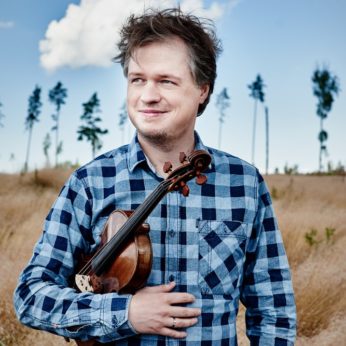Composer: Wolfgang Amadeus Mozart (b. 1756 - d. 1791)
Performance date: 05/07/2019
Venue: Bantry Library
Composition Year: 1788
Duration: 00:44:24
Recording Engineer: Ciaran Cullen, RTÉ
Instrumentation: vn, va, vc
Instrumentation Category:Trio
Artists:
Henning Kraggerud -
[violin]
Ellen Nisbeth -
[viola]
Emmanuelle Bertrand -
[cello]

Henning Kraggerud [violin], Ellen Nisbeth [viola], Emmanuelle Bertran [cello]
Wolfgang Mozart [1756-1791]
Divertimento in E flat K563 [1788]
1. Allegro
2. Adagio
3. Menuetto (Allegretto) – Trio
4. Andante
5. Menuetto (Allegretto) – Trio I, II
6. Allegro
Mozart’s E flat Divertimento is one of music’s best-kept secrets. It is a work of pure magic that towers above the rest of the string trio repertoire. For those out of the loop, the Divertimento title, redolent of eighteenth century light entertainment, distracts from the quality of the music. It was written for Johann Michael Puchberg, Mozart’s fellow Freemason, to whom he wrote a famous series of heart-rending letters begging for money. These so-called Bittbriefe continued for three years without disturbing their friendship. At Mozart’s untimely death, a thousand gulden was still outstanding, but Puchberg made no claim upon the estate. Constanze repaid him later. Mozart also wrote for him the E flat Piano Trio K542.
Mozart’s complicated finances have fascinated historians. His income was wildly unpredictable, and Mozart felt obliged to keep up his expensive way of life in imitation of court musicians like Salieri, who of course had the advantage of a regular salary. In 1788 the Emperor finally granted Mozart the title of court composer with a small stipend, his only duty being to write dances, a profitable but wearisome sideline. But even with the success of Don Giovanni, Mozart was obliged in the summer of 1788 to start borrowing from Puchberg, and to move to less expensive lodgings in the suburbs. This was where he wrote this Divertimento as well as his last three symphonies, with which he hoped to dazzle the Vienna public, who no longer came to hear his concertos.
In the spring of 1789, Mozart accepted an invitation to travel with Prince Lichnowsky through Bohemia and Saxony to Prussia and Silesia. When they arrived in Dresden, there was great excitement amongst the local musicians. A string trio was put together with Mozart playing viola, the court organist on violin and the visiting leader of Haydn’s Esterházy orchestra’s cellos on the cello; they gave a concert featuring the Puchberg Trio and arias from Figaro and Don Giovanni. Mozart’s fame was such that he got an immediate performance with the court orchestra in front of the Elector and a substantial fee. This same trip led to the commissioning of the so-called Prussian Quartets by King Frederick William. From these and other stories, it is clear that Mozart was now a legend everywhere except in Vienna, which, like Salzburg, would only idolise him once he was dead.
This is one of those works where words cannot begin to describe the music. It has a unique beauty that makes you want to laugh and cry at the same instant. There is something of Hermann Hesse’s magic theatre about this work; you open this unassuming door that you never noticed before and suddenly you are face to face with the composer himself making the purest, most exquisite music you have ever heard. A famous Danish actor visited Vienna that summer of miraculous achievement, and called on the legendary composer at home. This small man and great master improvised twice on a pianoforte with pedal and so wonderfully, so wonderfully, that it staggered belief! He interwove the most difficult passages with the loveliest themes. His wife cut quills for the copyist, a pupil composed, and a little boy of four walked about the garden singing recitatives. In short everything surrounding this splendid man was musical!
Francis Humphrys
Copyright © 2024 West Cork Music. All rights reserved.
Designed and developed by Matrix Internet